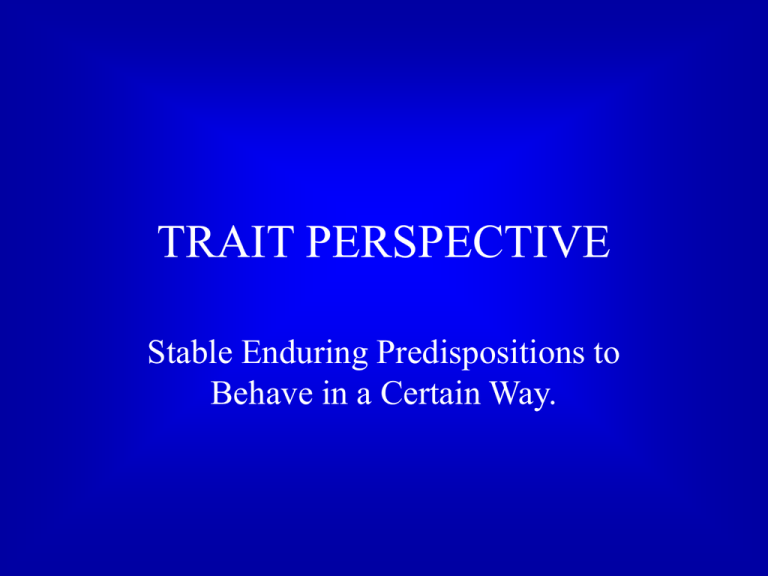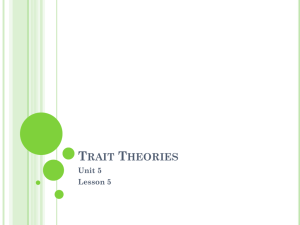trait theory
advertisement

TRAIT PERSPECTIVE Stable Enduring Predispositions to Behave in a Certain Way. Trait • A characteristic pattern of behavior or a disposition to feel and act, as assessed by self-report inventories and peer reports • Trait Perspective focus on individual differences rather than similarities like previous theories. • Trait theories seek to identify, describe and measure these individual differences. Types of Traits • Trait—relatively stable predisposition to behave in a certain way • Surface trait—characteristic that can be inferred from observable behavior • Source trait—Most fundamental dimensions of personality; very broad traits that are relatively few in number and give rise to surface traits. Ancient Greek Traits • Ancient Greeks classified four personality traits – Sanguine (cheerful) – Melancholic (depressed) – Choleric (irritable) – Phlegmatic (unemotional) • Felt these were caused by humor (body fluids) Gordon Allport (1897-1967) • American psychologist and trait theorist who researched the idea that individual personalities are unique • Studied the English dictionary and found more than 4,000 words describing specific personality traits. • Stressed importance of studying mentally healthy people • Resisted the idea of finding “personality law” that would apply to everyone Theorists • • • • Raymond Cattell—16 PF Hans Eysenck—Three factor model William Sheldon – Body Types model McCrae and Costa—Five factor model Raymond Cattell (1905-1998) • English psychologist who researched whether some traits predicted others • Used factor analysis to come up with 16 key personality dimensions or factors to describe personality • Proposed Each factor was measured on a continuum • Generally considered as too many traits Cattell’s 16 Personality Factors Example Questions and Profiles The 16PF, developed by Raymond Cattell, is a self-report inventory that contains 185 items like those shown in part (a). When scored, the 16PF generates a personality profile. In part (b), personality profiles of airline pilots and writers are compared. Cattell (1973) found that pilots are more controlled, more relaxed, more self-assured, and less sensitive than writers Hans Eysenck (1916-1997) • • • • • German psychologist who researched the genetically-influenced dimensions of personality Had 3 different source traits dimensions 1. Introversion-extraversion – Degree to which a person directs their energies inward toward themselves or outward onto others. 2. Emotional stability- Neuroticism (Stable – Unstable) – A person’s predisposition to become emotionally upset or stay emotionally even. 3. Psychoticism – Low in this means warm & caring toward others. – High in this means antisocial, cold, hostile & unconcerned about others. Generally considered as too few traits Using the first two dimensions he created 4 basic personality types (see next slide) Recent brain scan studies show specific personality traits can produce individual differences in the brain’s reaction to emotional stimuli (Focus on Neuroscience) Eysencks’ 4 Personality Types William Sheldon & body types (1898-1977) Your body type determines your personality Sheldon’s endomorph •Love of food •Love of comfort •Sociable •Good-humored •Relaxed •Tolerant Sheldon’s ectomorph •Self-conscious •Private •Introverted •Intense •Artistic •Restrained Sheldon’s mesomorph •Adventurous •Dominant •Courageous •Indifferent •Competitive •Risk-taker Five Factor Model • • • • Essential building blocks of personality can be described in 5 basic personality dimensions. Described somewhat differently among researchers but can be found cross culturally. Research shows them to be stable over time & consistent over different situations. 5 Factors—usually rated from low to high 1. 2. 3. 4. 5. • Extraversion Neuroticism Openness to Experience Agreeableness Conscientiousness Human behavior is the result of interaction between traits and situations. The “Big Five” Traits The “Big Five” Traits The “Big Five” Traits The “Big Five” Traits The “Big Five” Traits The Trait Perspective • Play “Personality Traits” (3:32) Segment #29 from Psychology: The Human Experience. Behavioral Genetics • Interdisciplinary field that studies the effects of genes and heredity on behavior • Heredity seems to play a role in four of the “big five” personality traits—extraversion, neuroticism, openness to experience, and conscientiousness • Influence of environment is at least equal to that of genetic factors. • Minnesota Study of Twins Reared Apart – found striking similarities in identical twins that did not occur in fraternal twins. • Similarities in identical twins may result from unique configuration of interacting genes called emergenic traits. Evaluation of Trait Perspective • Psychologists generally accept that people can be described & compared in terms of basic personality traits. BUT Trait Theory… • Doesn’t really explain personality, simply describe the behaviors • Doesn’t explain the development of the different behaviors/personalities • Fails to address how issues such as motives, unconscious, or beliefs about self affect personality development




